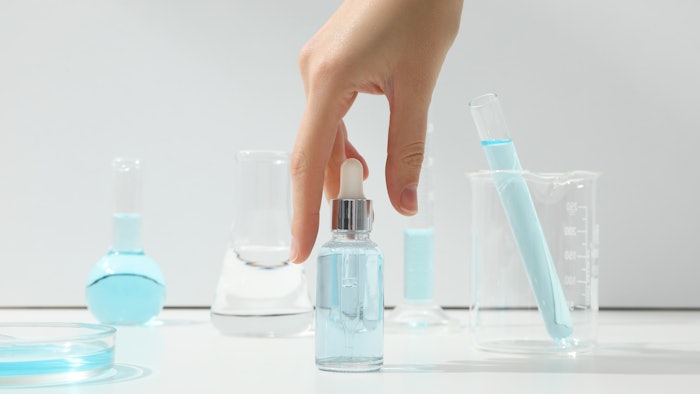
IFRA 51st Code of Practice Amendment
At the end of 2022, this column highlighted the International Fragrance Association (IFRA) Code of Practice, which includes standards for fragrance ingredients providing assurance that the fragrance ingredients and final combinations are complying with the highest level of safety, internationally. The IFRA Code of Practice is updated on a routine basis and last year, I explained the IFRA 49th amendment to its Code of Practice, the 50th amendment and the anticipated 51st amendment.
IFRA has now published its 51st amendment of the IFRA Code of Practice. It includes:
- Updated guidance for the use of the IFRA standards;
- Some amendments to IFRA standards;
- An annex on contributions from other sources to the IFRA standards, which combines (where applicable) information from natural contributions (former Annex I) as well as Schiff bases (former Annex II).
Full details of the 51st amendment, including implementation timelines, are available on the IFRA website.1
Fragrance Allergens
The European Commission has an ongoing intention to request information on fragrance allergens, in addition to the 26 ingredients currently listed in Annex III to the EU Cosmetic Products Regulation, to be provided to the consumer.
Background: Ingredient information is a cornerstone in the prevention of allergic contact dermatitis, as knowledge about the allergens to which a patient has been exposed is crucial for including the right substances in the allergy test by dermatologists; and for subsequent information on avoidance of re-exposure. Therefore, several fragrance allergens require labeling in a cosmetic product’s ingredient list if they are present over a certain threshold concentration.
Article 19 of both the EU and UK cosmetics regulations requires products containing fragrances to list the word parfum within the ingredients list. Furthermore, all fragrance allergens present in a cosmetic product – independent of whether these are coming from the fragrance, an essential oil or a natural extract, as examples – must also be labeled if they are present within the product above 0.01% for rinse-off products or 0.001% for leave-on products.
Fragrance allergens are regulated under Annex III of both the UK and EU cosmetics regulations. There are currently 26 fragrance allergens listed in Annex III, including: amyl cinnamal, anise alcohol, amylcinnamyl alcohol, benzyl benzoate, benzyl alcohol, benzyl cinnamate, benzyl salicylate, citronellol, cinnamyl alcohol, farnesol, cinnamal, hexyl cinnamal, citral, butylphenyl methylpropional (EU ban March 1, 2022; GB ban Dec. 15, 2022), coumarin, limonene, eugenol, linalool, geraniol, methyl 2-octynoate, hydroxycitronellal, alpha-isomethyl ionone, hydroxyisohexyl 3-cyclohexene carboxaldehyde (EU/UK ban Aug. 23, 2021), Evernia prunastri extract, isoeugenol and Evernia furfuracea extract.
The reason for this labeling requirement dates back several decades, when the European dermatology community raised concerns about levels of sensitization to fragrance ingredients they were seeing in their clinics. As a result, the Scientific Committee on Consumer Safety (SCCS) issued several opinions after investigating fragrance allergens and sensitization potential, which resulted in the requirements under the EU cosmetic products regulation to label the 26 fragrance allergens depending on the concentration in the cosmetic product.
New labeling requirements: As part of the continuous work investigating the safety of fragrance allergens in cosmetic products, the SCCS was requested to identify substances where processes, e.g. metabolism, oxidation and hydrolysis, may lead to cross-reactivity and therefore create new allergens. The SCCS issued its final opinion of this assessment in 2012, and since that date the commission has conducted an impact assessment, a public consultation and a study on fragrance allergen labeling on cosmetic products.
Cosmetics Europe, the European personal care association, has worked closely with the commission to help ensure that any new labeling is meaningful for the consumer and feasible for industry. In particular, Cosmetics Europe worked with the commission for a grouping approach to be part of the legislative proposal, for those fragrance allergens belonging to the same plant, helping to avoid a very long list of ingredients.
In July 2023, the European Commission published a new regulation2 in the Official Journal of the European Union updating the labeling requirements for fragrance allergens. This regulation amends some of the existing fragrance allergens entries in Annex III of the EU Cosmetic Products Regulation and adds 56 additional fragrance allergens. The additional fragrance allergens will follow the same threshold requirements for labeling as the existing 26 allergens: 0.01% for rinse-off products and 0.001% for leave-on products.
The transition periods for the new labeling requirements are:
- July 31, 2026 for placing on the market and;
- July 31, 2028 for making available on the market (off-shelf).
Cosmetics Europe is working on extensive guidance to help companies comply with these requirements, in particular the use of the grouping name.
UK: In this UK, this legislation applies in the European Union and Northern Ireland only. It will not apply in Great Britain (England, Scotland and Wales).
Siloxanes
As of the June 2023 column, there had been no further regulatory action taken at an EU level on the three cyclic siloxanes: cyclotetrasiloxane (D4), cyclopentasiloxane (D5) and cyclohexasiloxane (D6) under the cosmetics legislation (EU Cosmetic Products Regulation) and the chemicals legislation (Registration, Evaluation and Authorization of Chemicals, or REACH, Regulation). More recent actions have been taken.
EU REACH: The European Commission notified3 to the World Trade Organization (WTO) the draft regulation4 and its annex,5 implementing a new restriction for D4, D5 and D6 under the EU REACH regulation. The WTO notification was open for comment for 60 days from the date of notification; the draft regulation is expected to be published in the Official Journal of the European Union in Q4 2023. The expected restrictions are noted in Table 1.
 Table 1. Expected Restrictions on D4, D5 and D6
Table 1. Expected Restrictions on D4, D5 and D6
It is important to highlight that the anticipated implementation times are shorter than previously stated. The restriction proposal for D5 at 0.1% for leave-on products is likely to come into force three years from publication – not five years; and the proposed restriction for D6 of 0.1% in leave-on products will also have a shorter implementation of three years, instead of the previously expected five years. For REACH restrictions, the transition periods refer to “making available (off shelf).”
UK REACH: When the draft regulation4 notified to the WTO is published as final, it will be applicable in the EU and Northern Ireland. This regulation will not apply in Great Britain (GB; i.e., England, Scotland and Wales). No action in GB is planned to date but the Health and Safety Executive (HSE), the competent authority for implementing UK REACH, is carrying out an assessment on possible Regulatory Management Option Analysis (RMOA) for the cyclic siloxanes under UK REACH.
Stockholm Convention: In June 2023, the European Commission issued a proposal6 to add D4, D5 and D6 to the Stockholm Convention as Persistent Organic Pollutants (POPs). The proposal was open for public consultation until August 2023.
While, as documented in this article, there are environmental concerns and intended restrictions on D4, D5 and D6 at an EU level, the science is not universally aligned on the classification of D4, D5 and D6 as POPs and this action by the European Commission would set a precedent for regulating intermediates under the Stockholm Convention. We await the outcome of this proposal.
Microplastics
EU: In 2018, as part of its strategy for plastics in a circular economy, the European Commission requested the European Chemicals Agency (ECHA) to prepare an Annex XV Restriction Dossier under EU REACH concerning the use of intentionally added microplastic particles to consumer or professional use products of any kind. Cosmetics Europe has contributed to the REACH process on behalf of the cosmetics industry with robust and compelling evidence and argumentation. However, the ECHA has proposed banning the use of solid synthetic polymeric ingredients in consumer products of any kind, including cosmetic products, within the EU.
The restriction proposal has now been voted upon by the EU REACH committee. There are no significant changes from the original proposal issued in September 2022. In essence, the restriction is as follows:
Restriction concentration: 0.01% w/w
Definitions
- Microplastic means: “a material consisting of solid polymer-containing particles, to which additives or other substances may have been added, and where ≥ 1% w/w of particles have (i) all dimensions 0.1 µm ≤ x ≤ 5 mm; or (ii), for fibers, a length of 0.3 µm ≤ x ≤ 15 mm and length to diameter ratio of > 3.”
- Polymer is to be defined, as per Article 3 (5) REACH, as “a molecule that contains a sequence of at least 3 monomer units, which are covalently bound to at least one other monomer unit or other reactant.”
Definitions have also been provided for microbead, particle, solid, gas and liquid.
Scope
- Synthetic polymer microparticles shall not be placed on the market as substances on their own or, where the synthetic polymer microparticles are present to confer a sought-after characteristic, in mixtures in a concentration equal to or greater than 0.01% by weight.
- Natural, degradable and water-soluble polymers remain out of scope.
- Polymers without any carbon atoms in their structure are excluded from the scope of the restriction due to the absence of relevant ecotoxicity data on whether such polymers in particle form would pose the same risks as particles originating from polymers with carbon atoms in their structure.
- The commission considers that synthetic polymer microparticles below 0.1 µm pose an equivalent or potentially higher risk to the environment than particles between 0.1 µm and 5 mm. The definition of synthetic polymer microparticles is extended to cover polymers in or coating particles below 5 mm and fiber-like particles below 15 mm. However, the identification and quantification of particles below 0.1 µm currently pose analytical constraints because the particles are too small. To ensure legal certainty, in those cases where existing analytical methods or accompanying documentation are not able to determine the concentration of synthetic polymer microparticles in the product, the lower size limit of those microparticles for the purpose of enforcing the restriction should therefore be set at 0.1 µm.
Derogations include
- Polymers that are the result of a polymerization process that has taken place in nature, independently of the process through which they have been extracted, that are not chemically modified; and
- Polymers that are (bio)degradable, tested according to a specific process.
Biodegradation: Only polymers that degrade in multiple environmental compartments should be excluded from the scope of the restriction. It is widely accepted that a positive result in any of the screening test methods in groups 1-3 predicts degradability in all environmental compartments. Consequently, the commission considers that passing any of those test methods is sufficient to demonstrate degradability for the purpose of this restriction.
On the other hand, it is uncertain whether a polymer passing a group 4 or 5 test in one environmental compartment would have a similar degradation behavior in another compartment. Consequently, the commission considers that, where group 4 or 5 test methods are used, a polymer must pass those tests in at least three environmental compartments to be excluded from the scope of the restriction.
Transition periods: The following transition periods are still proposed in the voted restriction:
- Exfoliating microbeads – at entry into force;
- Rinse-off cosmetic products – 4 years;
- Leave-on cosmetic products – 6 years;
- Makeup, including lip and nail products – 12 years;
- Instructions for use and disposal – 2 years;
- Reporting to ECHA – 3 years; and
- Contains microplastics labeling on makeup – 8 years.
Labeling and reporting requirements: It is important to note that even if a product is derogated out of the scope of the ban because the “microplastic” ingredient no longer meets the definition of a microplastic when the product is used, companies still have some obligations regarding labeling and reporting.
For example, derogation 5b states that: “synthetic polymer microparticles the physical properties of which are permanently modified during intended end use in such a way that the polymer no longer falls within the scope of this entry.” This means that microplastics such as film-formers, which are no longer solid at the point of use, are still allowed to be used, but companies will need to fulfil some labeling and reporting obligations.
Ingredient suppliers will need to provide instructions for use and disposal for downstream users to avoid or minimize microplastic release in the environment and provide technical information on the polymers to downstream users. Suppliers will need to conduct yearly reporting to ECHA of the estimated release of the microplastic ingredient into the environment from the supplier’s own uses.
Finished product manufacturers must provide instructions for use and disposal for consumers, to avoid microplastic release to the environment of any unused product residue, through product labeling. Manufacturers also must conduct yearly reporting to ECHA on estimated microplastics releases to the environment from their own uses and use by downstream users.7
Next, the proposal will go to the European Council and Parliament. If neither the council nor Parliament oppose the restriction, it will be adopted. The EU Parliament and council are not expected to oppose the measures and this stage of the process is expected to take between one and three months. Following adoption of the restriction, it will be published and the transition periods noted will begin. This may occur before the end of 2023.
UK: The EU REACH restriction regarding microplastics will not apply in GB. An evidence project to review emissions of intentionally added microplastics and the risks they pose, both to human health and the environment, is under way. The results of this evidence project will be used to inform the UK government’s approach to managing intentionally added microplastics, whether through UK REACH or an alternative route.
UKCA/UK Conformity Mark
In September 2020, the Office for Product Safety and Standards (OPSS), the competent authority for UK cosmetics regulations, published guidance on the applicability of the new UK Conformity Mark (UKCA mark) as a substitute for the EU “CE mark” as the UK prepared to leave the EU.
While the applicability of the UKCA mark had been established for products that already carried the CE mark, the new guidance stated that: “The UKCA marking will apply to most goods currently subject to the CE marking. It will also apply to aerosol products.”
The CTPA and the British Aerosol Manufacturers Association (BAMA) requested further clarification from OPSS regarding the CE mark not being applicable to all aerosols, but only to aerosols that are classed as products for which the CE mark is mandatory. In addition, the UK aerosols regulation had initially provided for the UKCA mark or the reversed epsilon symbol (currently required under the EU Aerosol Dispensers Directive) to be affixed on pack, as either of them would have been accepted as self-certification that the aerosol complied with the relevant regulatory standards.
However, this was amended, meaning this alignment no longer existed. Deadlines for the new labeling requirements were issued and have been extended on several occasions. In July 2023, the UK Department for Business and Trade (DBT) announced7 its intention to introduce legislation to extend indefinitely the recognition of the CE marking for products placed on the market in GB. Therefore, while cosmetic aerosols sold in GB must have the UKCA marking on pack as proof that the aerosol complies with the requirements under the UK aerosols regulation, the new rules allow products sold in GB to continue to use either the reverse epsilon or the UKCA mark.
The UK Government has updated its guidance8 but no formal legislative proposal was in place at the time of the announcement.
UK Joins CPTPP
On July 16, 2023, the UK formally signed the treaty to accede to the Comprehensive and Progressive Agreement for Trans-Pacific Partnership (CPTPP) trade group, joining 11 countries across Asia and the Pacific. Being part of CPTPP will mean that more than 99% of current UK goods exported to CPTPP countries will be eligible for zero tariffs. In addition, CPTPP includes a cosmetics annex that lays provisions that each party agrees to abide by when signing the trade deal.
Notably, the cosmetics annex specifies that no party should require a cosmetic product to:
- Be labeled with a marketing authorization or notification number;
- Be accompanied by a Certificate of Free Sale (CFS) as a condition of marketing, distribution or sale in the party’s territory or;
- Be tested on animals to determine its safety, unless there is no validated alternative method available to assess safety.
The signature is the formal confirmation of agreement for the UK to join the group, following the substantial conclusion of negotiations earlier this year. The UK government will now seek to ratify the agreement, which will include parliamentary scrutiny, whilst other CPTPP countries complete their own legislative processes. The UK government expects to bring the agreement into force in 2024.
Final Thoughts
As this is my last column of 2023, it has been good to look back on a very busy and, on occasion, challenging year. There have been successes and disappointments – and some issues continue to be hot topics. May I send all good wishes for 2024.
References
- International Fragrance Association (IFRA) (2023). 51st Amendment to IFRA Code of Practice. Available at https://ifrafragrance.org/safe-use/standards-documentation
- European Commission (2023). Regulation to the European Cosmetic Products Regulation. Available at europa.eu
- World Trade Organization (WTO) (2023). Notification from the European Commission. Available at wto.org
- European Commission (2023). Draft Regulation to the EU Registration, Evaluation and Authorisation of Chemicals (REACH) Regulation. Available at 23_10468_00_e.pdf (wto.org)
- European Commission (2023). Draft Annex to the EU Registration, Evaluation and Authorisation of Chemicals (REACH) Regulation. Available at 23_10468_01_e.pdf (wto.org)
- European Chemicals Agency (ECHA) (2023). Nomination of D4, D5, and D6 for inclusion in the Stockholm Convention as POPs substances. Available at europa.eu
- UK Government (2023). Extension of CE mark recognition for businesses. Available at GOV.UK (www.gov.uk)
- UK Government (2023). Using the UKCA marking. Available GOV.UK (www.gov.uk)










